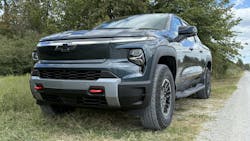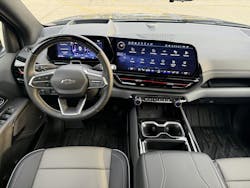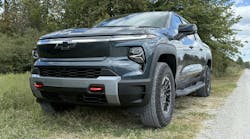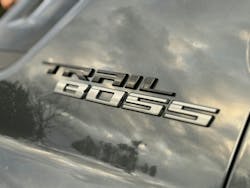In-depth review of the 2026 Silverado EV Trail Boss
Key takeaways
- The Silverado EV features a distinctive design with a beefy front end and rounded interior elements, setting it apart from traditional pickups.
- Available in four models with three battery options, it offers up to 494 miles of range and a maximum towing capacity of 12,500 lb.
- The truck includes innovative features like the eTrunk, Multi-Flex Midgate, and Multi-Flex Tailgate with entertainment system, enhancing utility and convenience.
- Driving impressions reveal a well-handling vehicle despite its weight, with a quiet cabin and advanced suspension tuning for a smooth ride.
The first time I saw the Chevrolet Silverado EV in person was at Work Truck Week 2022, barely two months after its global debut at the Consumer Electronics Show earlier that year. A shiny blue Silverado EV was on display in the Chevrolet booth and garnered a lot of attention.
I had the privilege of chatting with the brains behind the electric vehicle, Silverado EV Chief Engineer Nichole Kraatz, who stressed to me that this truck, designed from the ground up as an electric pickup, can perform as a work truck. Since then, I’ve been waiting for my opportunity to get behind the wheel. Recently, I got my chance.
The Silverado EV stands out immediately from other electric vehicles—and even gas-powered and diesel-powered pickups—with its distinct design. Few light-duty EVs on the streets are bigger than the Silverado EV, and it has a unique shape. Unlike the boxy 90-degree angles popular with today’s pickups, the Silverado EV features a beefy front end with the cab’s back pillars positioned at an angle similar to the front windshield. (Remember the Chevrolet Avalanche?)
Unlike ICE pickups, the interior of the Silverado EV has more streamlined, rounded features than the sharper angles found on the dash and glove compartments of ICE pickups. But we’ll get more into the interior later.
Let’s dive into what matters about this electric pickup truck.
GM’s fleet-focused Silverado EV elevator pitch
General Motors’ first electric pickup truck, the Silverado EV, is in its third model year. The 2026 Silverado EV offers 760 maximum hp, 775 lb.-ft. of maximum torque, and can tow up to 12,500 lb. The EV is available in four different models: the WT, Custom, LT, and Trail Boss.
Each model is available with three different battery packs: Standard Range, offering an estimated 286 miles; Extended Range, offering an estimated 424 miles; and Max Range, offering an estimated 494 miles. Worth noting, the higher the battery capacity, the lower the payload. For example, the WT with Standard Range battery offers a 2,350-lb. payload, whereas the Trail Boss with Max Range battery offers a 1,500-lb. payload.
The Silverado EV’s eTrunk offers 10.7 cu. ft. of cargo space, and when using the Multi-Flex Midgate, the bed of the truck can accommodate tools and equipment nearly 11-ft. long.
Prices range from $55,895 to well over $90,000, with the model we reviewed priced at $91,845.
Now that you know the specs, here’s how it performed for me:
How did the Silverado EV drive?
I drove the Silverado EV Trail Boss with the Max Range battery for a week. I took it everywhere, even across state lines.
The vehicle is heavy, weighing around 9,000 lb., thanks to its large battery pack. Yet it doesn’t feel heavy when behind the wheel. It handles well, and its suspension is fine-tuned. Though I wouldn’t describe the Silverado EV as “zippy” on busy highways, there were moments I glanced at the speedometer and was surprised I was going much faster than it felt. This is not only because of how the vehicle handled but also because of a quiet cabin that kept road noise at bay.
No review of the Silverado EV Trail Boss would be complete without a trip in the dirt. So, my husband and I took the truck about an hour south of Detroit to the Ottawa National Wildlife Refuge in Oak Harbor, Ohio. The trip down was pleasant, especially thanks to GM’s Super Cruise Technology—more on that to come. I also didn’t experience any range anxiety, as the integrated Google Maps showed the EV’s estimated battery percentage upon arrival before we even took off. The map also showed plenty of EV chargers along the way there and back, just in case we decided to charge during the trip.
At the wildlife refuge, our path turned from asphalt to gravel and dirt roads. Unfortunately, because the Midwest’s flat landscape doesn’t offer many 4x4 trails, including the wildlife drive, I didn’t get a full off-roading opportunity to test the Silverado EV Trail Boss. However, the Ottawa Wildlife Refuge offered enough miles of dirt and gravel for us to test the Terrain mode—which disables traction control and reduces electronic stability control for better performance on trails—and the Sidewinder feature. Other drive modes include Normal and Tow/Haul.
The Sidewinder is Chevrolet’s version of the GMC Crabwalk. In this mode, all four wheels turn in the same direction, allowing the truck to move diagonally. I drove it in Sidewinder for a nice stretch of dirt road. While it’s a cool feature to have, I can’t pinpoint a scenario where the Sidewinder would come in handy; however, it’s a fun party trick. (If you own a Silverado EV, GMC Hummer EV, or Sierra EV, let us know how you use Sidewinder and Crabwalk.)
Once we felt we had fully tested the Sidewinder, we enjoyed the rest of the wildlife drive and then headed back to the Motor City a couple of hours later.
Super Cruise
I employed the EV’s Super Cruise technology both to and from the wildlife refuge. Super Cruise isn’t new technology; it’s been around a few years and available on gas- and diesel-powered vehicles from the automaker. However, this was the first time I’d driven a Super Cruise-enabled vehicle and concluded that “game changer” is the best way to describe it.
Super Cruise is the brand’s “hands-free” driving technology. It uses radars, sensors, cameras, and GPS and mapping data to keep the vehicle within its lane at a consistent speed—without any driver assistance. But it’s more than just an adaptive cruise control system with lane keeping assist technology.
Super Cruise will automatically change lanes if there is a slow vehicle in the lane ahead and then return to the original lane once it has passed the slow vehicle. Drivers can also enable lane changes by activating the turn signal. Once the turn signal is activated, the truck will automatically maneuver into the next lane once it “senses” the lane is clear.
Because this is hands-free driving, one might believe it helps with driver fatigue, which would be a clear benefit for fleet drivers. One person I know owns a Super Cruise-equipped GMC Sierra. While they aren’t a fleet owner, they did tell me the feature is very useful and preferred when taking the multi-hour drive to their cabin on the weekends. However, I cannot back this claim as I didn’t take the vehicle out far enough or long enough to experience fatigue.
It is worth noting that Super Cruise technology is not available on all roads, but it is widely available across the U.S. and Canada. See the map below.
I used Super Cruise every opportunity I had, and while sometimes it was scary letting go of the wheel, I felt more at ease after having the tech enabled for a few minutes. By the end of my weeklong loan, I preferred traveling only on compatible roads because I appreciated the feature so much. For safety, Super Cruise will disable if sensors cannot detect that the driver’s eyes are on the road.
Features of the 2026 Silverado EV Trail Boss
Aside from driving the Silverado EV, the truck is full of nice-to-have features, from its Multi-Flex Midgate to the multiple outlets available both in the cab and in the bed of the truck.
The Multi-Flex Midgate elongates the bed of the truck by knocking down the walls of the cab. Simply fold the seats forward and press two buttons to bring the walls flush with the truck bed. The rear glass can also be stowed away safely within the truck if hauling taller equipment or supplies. The whole process—even when stowing the glass—takes two to three minutes.
Paired with the Multi-Flex Tailgate, the Silverado EV’s bed can become even longer (10 ft.-10 inches) by lowering the tailgate and using the integrated load stop. In addition to the load stop, the Multi-Flex Tailgate has multiple configurations to use in a variety of scenarios: as a step to get into the truck bed, a work surface, and more. What made this Multi-Flex Tailgate extra special was its integrated entertainment system, equipped with speakers and radio controls, allowing operators to listen to music while on the job.
There are 11 available outlets and 10.2 kW of onboard power within the Silverado EV. This enables the truck to power equipment using the electric battery. The truck also allows operators to limit the onboard power used, ensuring operators have plenty of juice for the drive home.
Finally, the 2026 Silverado EV is equipped with Chevy Safety Assist. This includes automatic emergency braking, front pedestrian braking, lane keep assist with departure warning, forward collision alert, following distance indicator, and automatic headlights.
Final thoughts on the 2026 Silverado EV
The 2026 Silverado EV is an impressive vehicle. From a personal standpoint—and if money were no object—if I needed a new pickup, I would likely consider the EV because of its comfortable features, capability, and greater range than competitors. But what keeps me from going all-in with the 2026 Silverado EV as a fleet truck is its price-to-capability ratio compared to its gas and diesel counterparts.
Chevrolet offers its Silverado EV in its basic WT (Work Truck) trim to commercial customers with three battery options: Standard (4WT); Extended (5WT); and Max (8WT). The Silverado EV 4WT starts at $52,800 with a maximum towing capacity of 8,500. A double cab standard bed gas-powered Silverado 1500 WT equipped with the TurboMax engine starts at $46,095 and offers a maximum towing capacity of 9,500 lb. A double cab standard bed diesel-powered Silverado 1500, the configuration that offers the highest towing capacity, in the LT trim starts at $56,840 and offers a maximum towing capacity of 13,300 lb. Because of these differences, the capability and cost can be significant factors in deciding between an EV or an ICE pickup for your business.
However, there have already been cases made for the Silverado EV in fleet applications. FleetOwner covered how McKinstry uses the electric pickups in its fleet, and I’ve seen multiple Silverado EVs around town with logos of Detroit’s local utility, DTE, on them.
Bottom line: If your business doesn’t typically haul more than 8,500 lb. over roughly 200 miles, and if you’ve been waiting for an electric pickup with range comparable to a full tank of gas or diesel, this truck could very well be the answer.
About the Author
Jade Brasher
Senior Editor Jade Brasher has covered vocational trucking and fleets since 2018. A graduate of The University of Alabama with a degree in journalism, Jade enjoys telling stories about the people behind the wheel and the intricate processes of the ever-evolving trucking industry.







